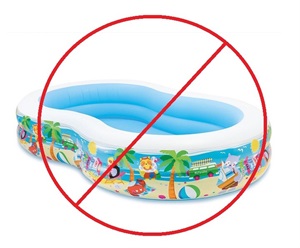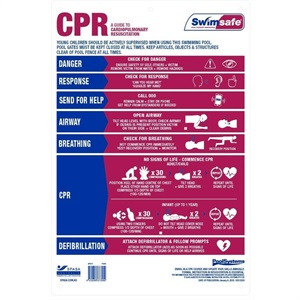Residential Swimming Pool and Spa Requirements
Before you purchase an inflatable or portable pool or spa, please contact Council to check whether you need approval and a compliant swimming pool barrier.


Ensure that young children are supervised AT ALL TIMES when in the pool area. Do not rely on floaties, pool noodles or any other aids to keep your child safe. Never purposely keep the pool gate open and empty or put away any small pool immediately after each use.
Legislative Requirements
Swimming Pool Fence
Any residential pool or spa (including portable or inflatable pools) that can hold more than 30cm of water must have a complaint swimming pool barrier. In NSW, the walls of the swimming pool may not act as the barrier and a separate fence must be erected to separate the pool from any residential building and adjoining premises.
Development Consent (Approval)
If the pool has a maximum volume of more than 2000L, you must have an appropriate approval from Council or a Private Certifier before it is built or erected.
Registration
All swimming pools must be correctly registered on the NSW Swimming Pools Register.
Warning Notices
An approved resuscitation sign must be visibly available within the pool area at all times. When purchasing a new sign, check the date on the sign to ensure that is a current one as the contents of the sign were changed in 2019. Council has compliant signs for sale at the Administration Centre.
Failure to comply with any of these requirements may result in the issue of Orders or Directions, fines and/or commencement of court proceedings.
Examples:



The above posters are compliant with the Swimming Pools Regulation 2018 because they contain all of the following:
- The words —
- “Young children should be actively supervised when using this swimming pool”, and
- “Pool gates must be kept closed at all times”, and
- “Keep articles, objects and structures clear of the pool fence at all times”
- A simple flow chart (which may be the flow chart depicted in the Cardiopulmonary Resuscitation Guideline) containing details of resuscitation techniques —
- That are set out in accordance with the relevant provisions of that Guideline, and
- that comply with the other relevant guidelines of the Australian Resuscitation Council
- a statement to the effect that formal instruction in resuscitation is essential
- the name of the teaching organisation or other body that published the sign and the date of its publication.
Inspections
Complaints
In accordance with Councils Swimming Pool Program, Council investigates complaints regarding non-compliant swimming pool barriers and unauthorised swimming pools. Should you wish to lodge a complaint you may do so online Report a Problem Fairfield City Council (nsw.gov.au) or by calling Council on 9725 0222.
Certificates of Compliance
Properties sold with a pool must have one of the following attached to the sale contract:
- a valid occupation certificate less than 3 years old;
- a valid certificate of compliance; or
- a valid certificate of non-compliance.
If a certificate of non-compliance is attached to the contract, the purchaser takes on the obligation to obtain a certificate of compliance. They will have 90 days from settlement to rectify defects listed in the certificate of non-compliance and obtain a certificate of compliance. Please note that the 90 days does not apply to properties where the certificate states that the swimming pool poses a significant risk to public safety.
A valid certificate of compliance or relevant occupation certificate must be attached to new residential tenancy agreements to rent a property with a swimming pool or spa pool.
For the purpose of obtaining a Certificate of Compliance, an inspection may be requested from either a) Council or b) a suitably qualified private pool inspector.
- Council - If the requirements to issue a Certificate of Compliance have not been met at the time of the inspection, Council will issue a Certificate of Non-Compliance. Please note that the owner of the premises has a legislative requirement to ensure that at all times, the swimming pool is surrounded by a compliant barrier. If the barrier is found to be non-compliant, Council has a regulatory obligation to commence enforcement action and will issue a Direction pursuant to Section 23 Swimming Pools Act 1992 to carry out work. In cases where there is an extended or delayed settlement period, the current owner will be required to carry out works to comply with the Direction.
- Private swimming pool inspector - If the requirements to issue a Certificate of Compliance have not been met at the time of the inspection, the private swimming pool inspector is required to issue a Certificate of Non-Compliance and a Notice pursuant to Section 22E Swimming Pools Act 1992 to carry out work. If the inspector is of the opinion that the swimming pool poses a risk to public safety, they are required to immediately forward a copy of the Notice to Council. If not, a copy of the Notice must be forwarded to Council 6 weeks after the date of inspection if a certificate of compliance is not issued for the swimming pool before that time.
Application for Certificate of Compliance for Swimming Pool Fence
Swimming Pool Certificate of Compliance - FAQs
Spa Pools
A spa pool is not required to be surrounded by a child resistant barrier if it is covered and secured by a child-resistant lid that complies with the standards set out in Section 9 Swimming Pool Regulation 2018. The child-resistant lid is to be lockable and kept locked whenever the spa is not in actual use.
Swim Spas are required to be surrounded with a compliant swimming pool barrier and are not subject to this exemption.
As defined under AS 2610.2-2007
1.3.23 Spa pool
A water-retaining structure fitted with filtration and sanitizing equipment, a heater, equipment for creating turbulent water and a skimmer system, normally filled with water except for maintenance purposes, and not intended to be used for swimming.
Supervision
A report undertaken by the Royal Lifesaving Australia found causes of distraction that lead to supervision lapses in cases of fatal drowning of children 0-4 years. That study found the most common causes of distraction from supervision were:
- indoor household duties – such as putting on washing, washing up, cooking dinner, checking on dinner, putting clothes in dryer, tidying up, collecting pyjamas or forgotten items and bringing them to the bathroom, using the toilet/showering
- outdoor household duties – such as hanging washing outside, gardening, taking garbage out, outdoor household repairs
- talking/socialising – talking or socialising in person, either inside or outside the house
- electronic distractions – such as using the computer, using the phone and indoor recreation activities such as watching movies, watching TV or playing computer games
- childcare – taking care of children, either a parent’s own children or unrelated children.
Proper supervision means giving ALL of your attention, ALL of the time with NO distractions
Demolition or Removal of a Swimming Pool
You must have an appropriate approval from Council or a Private certifier before you start to demolish or remove your swimming pool. Failure to do so could result in the issue of Orders or Directions, fines and/or commencement of court proceedings.
Ponds & Water Features
Ponds or water features are not subject to the requirements of the Swimming Pools Act 1992. But they must have an appropriate approval or comply with Subdivision 40 of the State Environmental Planning Policy (Exempt and Complying Development Codes) 2008.
Changing the use of a pool to a pond requires approval with Council. In the absence of an appropriate approval to change the use of the swimming pool, the pool area is still subject to requirements of the Swimming Pools Act 1992 and therefore must be surrounded by a compliant child-resistant barrier.
Additional Information
More information regarding swimming pool safety
Copies of Australian Standards for Safety Barriers for Swimming Pools are available to view at the reception of Councils Administration Building – 86 Avoca Rd, Wakeley NSW